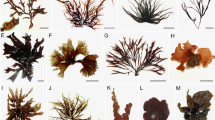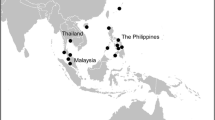Abstract
Subtribe Coelogyninae (Epidendroideae, Orchidaceae) comprises of 16 genera. The present study is undertaken to develop DNA barcodes of subtribe Coelogyninae using rbcL. It reveals the sectional delineation and its relationship with Pholidota. DNA barcoding is a technique which helps identification of species even if only small fragment of organism is available at any stage. The rbcL (Rubisco large subunit) from chloroplast genome is tested for effective barcoding. The interspecific divergence values and species discrimination rates were calculated by Kimura 2 parameter using MEGA 4.0. The rbcL with average interspecific divergence values yielded 72.72 % species resolution, thus it could distinguish all the species of Coelogyne and Pholidota. Invariably the genus Pholidota shows close affinity with Coelogyne. This supports the inclusion of genus Pholidota in the subtribe Coelogyninae of tribe Coelogyneae.


Similar content being viewed by others
References
Mabberley DJ (2008) Mabberley’s plant book: a portable dictionary of plants, their classification and uses, revised, 3rd edn. Cambridge University Press, Cambridge
Kumar CS, Manilal S (1994) A catalogue of Indian orchids. Bishen Singh Mahendra Pal Singh, Dehra Dun
Butzin F (1992) Subtribus Coelogyninae. In: Brieger G, Maatsch B, Senghas K (eds) Die Orchideen 1A. Verlag Paul Parey, Berlin, pp 914–958
Comber J (1990) Orchids of Java. Royal Botanic Gardens, Kew
Cameron KM, Chase MW, Whitten WM, Kores PJ, Jarrei DC, Albert VA, Yukava T, Hills HG, Goldman GH (1999) A phylogenetic analysis of the Orchidaceae: evidence from rbcL nucleotide sequences. Am J Bot 86:208–224
Soltis DE, Soltis PS (1998) Choosing an approach and an appropriate gene for phylogenetic analysis. In: Soltis DE, Soltis PS, Doyle JJ (eds) Molecular systematic of plants II: DNA Sequencing. Kluwer, Dordrecht, pp 21–24
Sanderson JM (2003) r8 s: inferring absolute rates of molecular evolution and divergence times in the absence of a molecular clock. Sci Math Bioinform 19(2):301–302
Alberts B, Bray D, Levis J, Raff M, Roberts M, Watson JD (1994) Molecular biology of cell. Gerland Publishing Inc, New York
Yukawa T, Uehara K (1996) Vegetative diversification and radiation in subtribe Dendrobiinae (Orchidaceae), evidence from chloroplast DNA phylogeny and anatomical characters. Plant Syst Evol 201:1–14
Sing HK, Parveen I, Raghuvamshi S, Babbar SB (2012) Loci recommended as universal barcode for plants on the basis of floristic studies may not work with congeneric species as exemplified by DNA barcoding of Dendrobium species. BMC Res Notes 5:42
Parveen I, Singh K, Raghuvamshi S, Pradhan UC, Babbar SB (2012) DNA bar coding of endangered Indian Paphiopedilum species. Mol Ecol Resour 12:82–90
Ratnasingham N, Hebert PDN (2007) BOLD: the barcode of life data system (http://barcodinglife.org). Mol Ecol Notes 7: 355–364
Parab GV, Krishnan S (2008) Assessment of genetic variation among populations of Rhynchostylis retusa, an epiphytic orchid from Goa, India using ISSR and RAPD markers. Indian J Biotechnol 7:313–319
Khasim SM, Ramesh G (2010) Molecular and morphological studies in Vanda tessellata, an epiphytic orchid from Eastern Ghats of India. In: Blanchard MG, Runkle ES, Lee Y-I (eds) Proceedings of the ISHS international orchid symposium, vol 878. Acta Horticulturae, Belgium, pp 63–70
Chaudhary B, Chattopadhyay P, Verma N, Banarjee N (2012) Understanding the phylomorphological implications of pollinia from Dendrobium (Orchidaceae). Am J Plant Sci 3:816–828
Ramudu J, Ramesh G, Khasim SM (2012) Molecular and morphological studies in Coelogyne nervosa A. Rich., an endemic orchid from South India. J Orchid Soc India 26(1–2):53–58
Doyle JJ, Doyle JL (1987) A rapid DNA isolation procedure from small quantities of fresh leaf tissue. Phytochem Bull 19:11–15
Sanger F, Nicklen S, Coulson AR (1977) DNA sequencing with chain-terminating inhibitors. Proc Natl Acad Sci (USA) 74:5463–5467
Tamura K, Dudley J, Nei M, Kumar S (2007) MEGA4: molecular evolutionary genetics analysis (MEGA) software version 4.0. Mol Biol Evol 24:1596–1599
Ross SW, Murugan S, Li WLS (2008) Testing the reliability of genetic methods of species identification via simulation. Syst Biol 57:216–23027
Dressler RL (1993) Phylogeny and classification of the orchid family. Cambridge University Press, Cambridge
Meyer CP, Paulay G (2005) DNA barcoding: error rates based on comprehensive sampling. PLoS Biol 3:2229–2238
Lahaye R, Bank VDM, Bogarin D, Warner J, Puplin F, Gigot G, Maurin O, Duthoit S, Barraclough TG, Savolainen V (2008) DNA barcoding the floras of biodiversity hotspots. Proc Natl Acad Sci (USA) 105:2923–2928
Das S, Jain SK (1980) Fascicles of flora of India fascicles 5 Orchidaceae: genus Coelogyne. BSI, Calcutta
Gravendeel B, Vogel EF (2000) Total evidences of phylogeny of Coelogyne and allied genera (Coelogyninae, Epidendroideae, Orchidaceae) based on morphological, anatomical and molecular characters. In: Gravendeel B (ed) Reorganizing the orchid genus Coelogyne: a phylogenic classification based on morphology and molecules. National Herbarium, Leiden
Gravendeel B, Chase MW, de Vogel EF, Roos MC, Mes TH, Bachmann K (2001) Molecular phylogeny of Coelogyne (Epidendroideae; Orchidaceae) based on plastid RFLPs, matK, and nuclear ribosomal ITS sequences; evidence for polyphyly. Am J Bot 88:1915–1927
Subedi A, Vermeulen JJ, Chaudhury RP, Jin XH, Gravendeel B (2011) A taxonomic revision of Coelogyne sec. Ocellatae (Orchidaceae), 2nd chapter (in review with Ann. Mo. Bot. Hard). In: New species, pollination Interactions and Pharmaceutical Potential of Himalayan Orchids, Ph.D. thesis (1976), published by National Herbarium of Netherlands, Leiden University, Netherlands, pp 13–58
Ramudu J (2015) Morphological and molecular studies in some India Epidendroidea (Orchidaceae) Doctoral thesis, Acharya Nagarjuna University, Indian
Acknowledgments
Thanks are due to University Grants Commission for providing fellowship in the form of Rajiv Ghandi National Fellowship to J. Ramudu; also grateful to Dr. M. U, Sharief, Orchid Specialist, National Orchidarium and Experimental Garden, Yercaud (Tamil Nadu), India for identification of orchids.
Author information
Authors and Affiliations
Corresponding author
Ethics declarations
Conflict of interest
Authors have declared that no conflict of interest exists.
Rights and permissions
About this article
Cite this article
Khasim, S.M., Ramudu, J. Deoxyribonucleic Acid Barcoding of Some Indian Coelogyninae (Orchidaceae). Proc. Natl. Acad. Sci., India, Sect. B Biol. Sci. 88, 277–284 (2018). https://doi.org/10.1007/s40011-016-0756-5
Received:
Revised:
Accepted:
Published:
Issue Date:
DOI: https://doi.org/10.1007/s40011-016-0756-5




